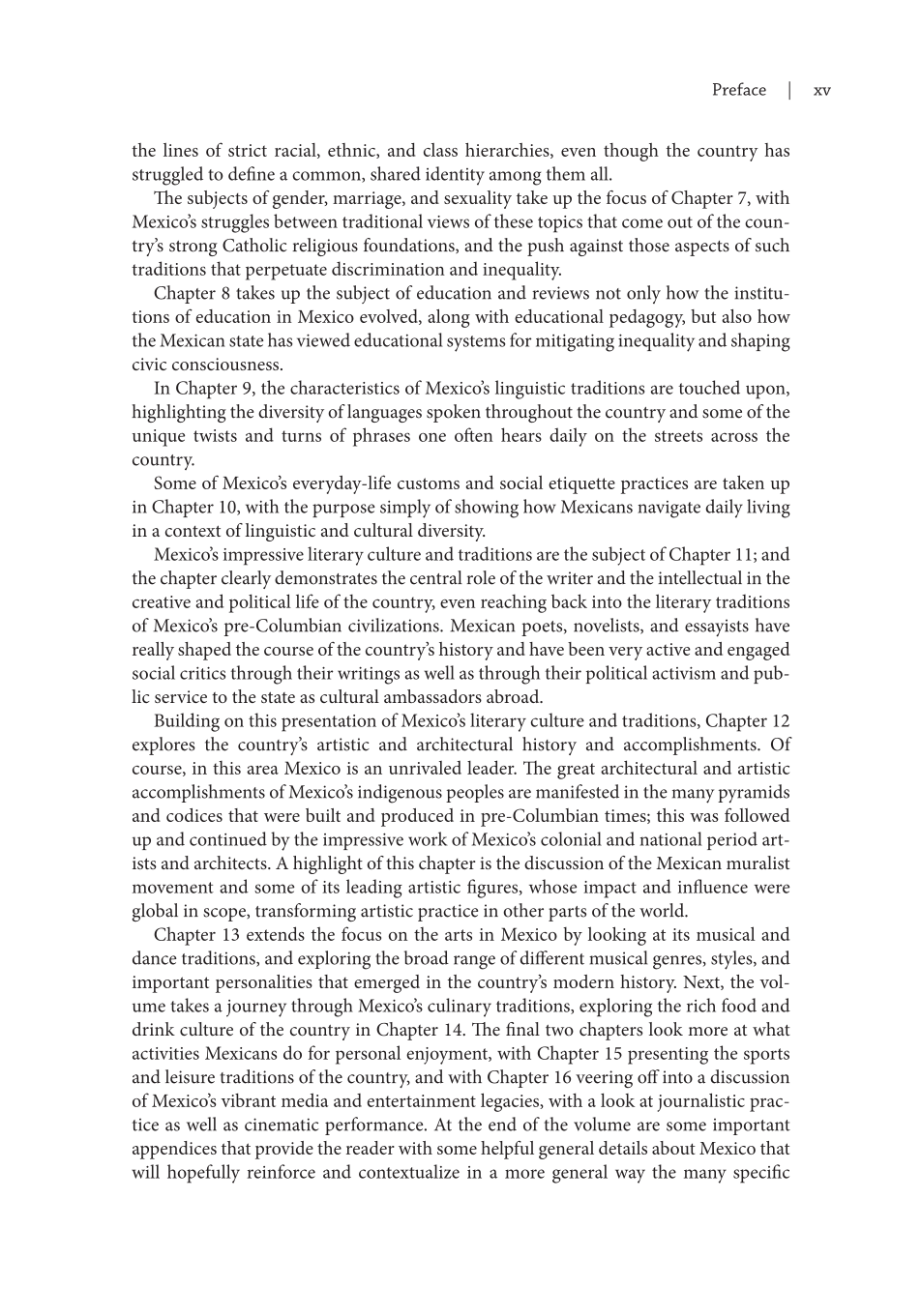xv Preface |
the lines of strict racial, ethnic, and class hierarchies, even though the country has
struggled to define a common, shared identity among them all.
The subjects of gender, marriage, and sexuality take up the focus of Chapter 7, with
Mexico’s struggles between traditional views of these topics that come out of the coun-
try’s strong Catholic religious foundations, and the push against those aspects of such
traditions that perpetuate discrimination and inequality.
Chapter 8 takes up the subject of education and reviews not only how the institu-
tions of education in Mexico evolved, along with educational pedagogy, but also how
the Mexican state has viewed educational systems for mitigating inequality and shaping
civic consciousness.
In Chapter 9, the characteristics of Mexico’s linguistic traditions are touched upon,
highlighting the diversity of languages spoken throughout the country and some of the
unique twists and turns of phrases one often hears daily on the streets across the
country.
Some of Mexico’s everyday-life customs and social etiquette practices are taken up
in Chapter 10, with the purpose simply of showing how Mexicans navigate daily living
in a context of linguistic and cultural diversity.
Mexico’s impressive literary culture and traditions are the subject of Chapter 11; and
the chapter clearly demonstrates the central role of the writer and the intellectual in the
creative and political life of the country, even reaching back into the literary traditions
of Mexico’s pre-Columbian civilizations. Mexican poets, novelists, and essayists have
really shaped the course of the country’s history and have been very active and engaged
social critics through their writings as well as through their political activism and pub-
lic service to the state as cultural ambassadors abroad.
Building on this presentation of Mexico’s literary culture and traditions, Chapter 12
explores the country’s artistic and architectural history and accomplishments. Of
course, in this area Mexico is an unrivaled leader. The great architectural and artistic
accomplishments of Mexico’s indigenous peoples are manifested in the many pyramids
and codices that were built and produced in pre-Columbian times; this was followed
up and continued by the impressive work of Mexico’s colonial and national period art-
ists and architects. A highlight of this chapter is the discussion of the Mexican muralist
movement and some of its leading artistic figures, whose impact and influence were
global in scope, transforming artistic practice in other parts of the world.
Chapter 13 extends the focus on the arts in Mexico by looking at its musical and
dance traditions, and exploring the broad range of different musical genres, styles, and
important personalities that emerged in the country’s modern history. Next, the vol-
ume takes a journey through Mexico’s culinary traditions, exploring the rich food and
drink culture of the country in Chapter 14. The final two chapters look more at what
activities Mexicans do for personal enjoyment, with Chapter 15 presenting the sports
and leisure traditions of the country, and with Chapter 16 veering off into a discussion
of Mexico’s vibrant media and entertainment legacies, with a look at journalistic prac-
tice as well as cinematic performance. At the end of the volume are some important
appendices that provide the reader with some helpful general details about Mexico that
will hopefully reinforce and contextualize in a more general way the many specific

































































































































































































































































































































































































